|
Back
| Table
of Contents | Next...
This chapter presents estimates of the
number of child maltreatment investigations conducted in
Canada during 1998. To aid the reader, the data are
first presented in terms of the estimated total number
of child investigations, as well as the annual incidence
rate calculated per 1,000 children aged 0 to 15 years.
These figures refer to child investigations, not to the
number of investigated families. Thus, if several
children in a family had each been reported as abused or
neglected, each investigated child counted as a separate
child investigation. Investigations of individual
categories of maltreatment (physical and sexual abuse,
neglect, andemotional maltreatment) are first described,
followed by information on the characteristics of
substantiated cases.
Total Child Investigations and Overall Rates of
Substantiation
An estimated 135,573 child maltreatment
investigations were conducted in Canada in 1998. This
figure corresponds to an estimated incidence rate of
21.52 investigations per 1,000 children. It is important
to keep in mind, however, that this incidence rate
includes all child maltreatment investigations,
regardless of whether the report was substantiated or
not.
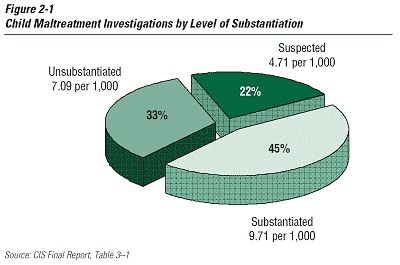
F

For physical abuse as the primary reason
for investigation, the incidence rate of substantiated
cases was an estimated 2.25 per 1,000 children in 1998.
Sexual abuse, as the primary reason for investigation,
was substantiated in 0.86 cases per 1,000 children,
while neglect, as the primary reason for investigation,
was substantiated in 3.66 cases per 1,000 children in
1998. Finally, for emotional maltreatment as the primary
reason for investigation, the incidence rate of
substantiated cases was 2.20 per 1,000 children in 1998.
These four rates add up to an estimated 8.97 cases per
1,000 children in which the primary reason for
investigation was substantiated. The difference between
9.71 per 1,000 (the overall incidence of substantiated
investigations) and 8.97 per 1,000 — 0.74 per 1,000 — is
accounted for by those cases in which a form of
maltreatment other than the primary reason for
investigation was substantiated.17
We now turn to substantiated cases of
specific categories of maltreatment, and look at the
characteristics of each.
Physical Abuse
Physical abuse is the deliberate
application of force to any part of a child’s body,
which results or may result in a non-accidental injury.
It may involve hitting a child a single time, or it may
involve a pattern of incidents. Physical abuse also
includes behaviour such as shaking, choking, biting,
kicking, burning or poisoning a child, holding a child
under water, or any other harmful or dangerous use of
force or restraint. Child physical abuse is usually
connected to physical punishment or is confused with
child discipline.
For the purposes of the CIS, cases of
investigated maltreatment were classified as physical
abuse if the investigated child was thought to have
suffered, or to be at substantial risk of suffering,
physical harm at the hands of the alleged perpetrator.
The physical abuse category includes three subtypes or
forms of abuse:
Figure 2-3 shows that the majority (69%)
of the substantiated investigations of physical abuse
involved in appropriate punishment, although other Read More ..
severe forms of abuse accounted for almost one-third
(31%). Shaken Baby Syndrome, in contrast, accounted for
approximately 1% of the substantiated
investigations.
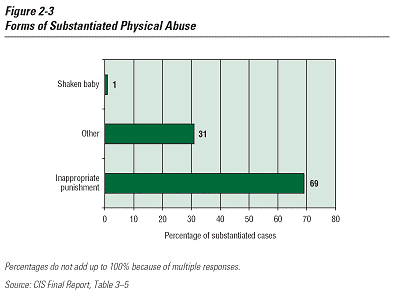
Sexual Abuse
Sexual abuse occurs when a child is used
for sexual purposes by an adult or youth. Sexual abuse
includes fondling a child’s genitals, intercourse,
incest, rape, sodomy, exhibitionism, and commercial
exploitation through prostitution or the production of
pornographic materials.
The CIS tracked seven forms or subtypes of
sexual abuse, ranging from sexual activity to sexual
harassment. If more than one form of sexual abuse was
reported for the same incident, workers were asked to
identify the most intrusive form. The CIS documented
only those cases reported to, and investigated by, child
welfare services: many cases of child sexual abuse that
do not involve parents or relatives in the home are
investigated only by the police. Child welfare services
usually become involved in extra-familial sexual abuse
cases only if there are concerns about the parents’
ability to protect the child.
The seven forms of sexual abuse include
the following:
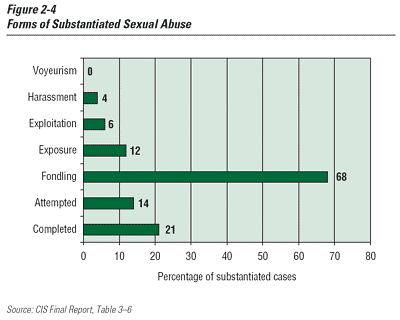
As shown in Figure 2-4, touching and
fondling of the genitals was the most common form of
substantiated child sexual abuse (68% of cases).
Attempted and completed intercourse together accounted
for over one-third (35%) of all substantiated
investigations, and an adult exposing genitals to a
child accounted for 12%. Sexual harassment and sexual
exploitation were less common, and the number of cases
of voyeurism was insufficient to permit reliable
estimates of that particular form of sexual abuse.
Please note that because multiple forms of sexual abuse
were sometimes reported, the individual subtypes add up
to more than 100%.
Neglect
Child neglect occurs when a child’s
parents or other caregivers are not providing the
requisites of a child’s emotional, psychological, and
physical development. Physical neglect occurs when a
child’s needs for food, clothing, shelter, cleanliness,
medical care and protection from harm are not adequately
met. Emotional neglect occurs when a child’s need to
feel loved, wanted, safe, and worthy is not met.
Emotional neglect can range from cases in which the
caregiver is simply unavailable, to cases in which the
caregiver openly rejects the child. Although a case of
physical assault is more likely to come to the attention
of public authorities, neglect can represent an equally
serious risk to a child.
Unlike abuse, which is usually
incident-specific, neglect often involves chronic
situations that are not as easily identified as specific
incidents. Nevertheless, all provincial and territorial
child welfare statutes include neglect or some type of
reference to acts of omission, such as failure to
supervise or protect, as grounds for investigating
maltreatment. The CIS includes eight subtypes or forms
of neglect:
Child neglect was the most frequently
investigated category of maltreatment, and had the
second highest rate of substantiation. As shown in
Figure 2-5, neglect primarily involved failure to
supervise the child properly, which led to physical harm
(48%). Parents’ reported failure to adequately meet the
physical needs of children (physical neglect) accounted
for the next largest percentage of substantiated reports
(19%), followed by permitting criminal behaviour (14%),
abandonment (12%), and educational neglect (11%).
Medical neglect and failure to provide necessary
treatment for a child were less commonly reported.
Again, because of multiple forms of neglect reported,
the individual subtypes add up to more than 100%.
Emotional Maltreatment
Emotional maltreatment harms a child’s
sense of self, and involves acts or omissions by the
parent or caregiver that have caused, or could cause,
serious behavioural, cognitive, emotional, or mental
disorders. Examples of emotional maltreatment include
verbal threats and put-downs, forcing a child into
social isolation, intimidating, exploiting, terrorizing
or routinely making unreasonable demands on a child.
Emotional maltreatment typically has been a difficult
form of maltreatment to define, because it often does
not involve a specific incident or visible injury. In
addition, its effects, although often severe, may not
become apparent until later on in the child’s
development. Four forms of emotional maltreatment were
tracked by the CIS:
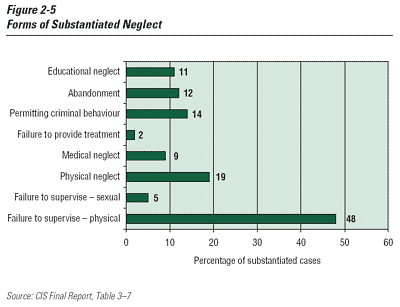

Figure 2-6 reveals that children’s
exposure to family violence was the most common form of
emotional maltreatment, accounting for well over half
(58%) of the substantiated cases. Emotional abuse (34%)
and emotional neglect (16%) were also fairly common,
whereas non-organic failure to thrive occurred too
infrequently to be estimated. Because multiple forms of
emotional maltreatment were sometimes reported, the
individual forms add up to more than 100%.
Characteristics of Substantiated Maltreatment
Child maltreatment appears in many
different forms, and is seldom caused by a single
factor. Significantly, maltreatment emerges within the
context of a troubled family or individual, who is often
facing considerable stress from factors both within and
outside of the family. Numerous risk factors, ranging
from financial difficulties to limited community
resources, increase the likelihood that a given
individual will resort to harmful childrearing methods.
Yet, these same risk factors are often shared by other
families who do not harm their children, despite high
levels of stress. This latter finding underscores the
fact that child maltreatment typically results from the
interaction of individual, familial, and cultural
influences, many of which are documented by the CIS.
This section describes the characteristics
of the major categories of substantiated maltreatment
documented by the CIS. The characteristics of
maltreatment include evidence of associated physical and
emotional harm, the duration of the maltreatment, and
children’s relationships to the perpetrators, all of
which have been shown to be related to increased child
distress.19
The findings are presented in terms of the four major
categories of primary maltreatment tracked by the CIS
(physical abuse, sexual abuse, neglect, and emotional
maltreatment) for substantiated cases only.
Duration
Duration of maltreatment was documented on
a three-point scale as follows:
Well over one-third (43%) of all
substantiated cases of child maltreatment continued
beyond 6 months in duration. Single incidents and those
continuing for less than 6 months in duration accounted
for another 44% of the cases. In the remaining cases,
investigating workers were not able to determine the
duration.
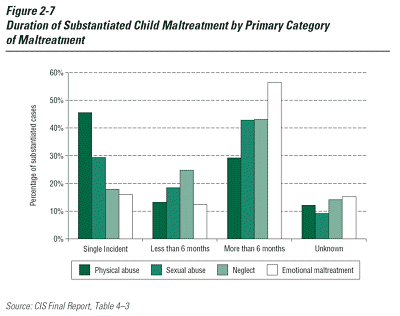
Figure 2-7 shows that emotional
maltreatment was most likely to have continued beyond 6
months (56% of substantiated emotional maltreatment was
over 6 months in duration), followed by sexual abuse
(43%), neglect (43%), and physical abuse (29%). The
figure also reveals that physical abuse and sexual abuse
were somewhat more likely to involve single incidents
(46% and 29% respectively) than the other two categories
of maltreatment. This latter finding is understandable,
given that both of these categories of maltreatment
involve Read More ..adily identified acts or behaviours that
are reported, whereas neglect and emotional maltreatment
are more likely to be considered chronic conditions with
less specific incidents.
Physical and Emotional Harm
The CIS tracked physical harm suspected or
known to be caused by the investigated maltreatment.
This included suspicious injuries that were subsequently
found not to be due to maltreatment, as well as injuries
caused by maltreatment.
The nature of the physical harm was
documented by investigating workers according to six
types of injury or health condition:
Across all categories of maltreatment,
physical harm was documented in 17% of substantiated
cases. About three-quarters of the cases involving
physical harm did not require treatment, whereas in the
remaining one quarter (4% of the total number of
substantiated cases) the harm was sufficiently severe to
require medical treatment. Most of this harm (65%)
involved bruises, cuts, and scrapes, although there were
other significant injuries and health conditions
resulting from maltreatment as well.
During the 3-month CIS data collection
period there was one investigation of a child abuse and
neglect fatality at a participating site. This is an
insufficient number to allow for the calculation of a
national estimate. An average of about 100 child
homicides are documented by the police every year across
Canada according to the Homicide Survey, which provides
information on police-reported characteristics of
homicides.20
Not surprisingly, physical abuse was the
most common primary category of maltreatment that
resulted in physical harm: almost half (44%) of all
substantiated physical abuse cases documented physical
harm, and some form of medical treatment was required in
6% of these cases. The vast majority of injuries (86%)
involved bruises, cuts, and scrapes, and the remaining
injuries were evenly distributed over the other
types.
Physical harm was also documented in all
other primary categories of maltreatment, although to a
significantly lesser extent (sexual abuse 8%, neglect
9%, emotional maltreatment 1%). The nature of the
physical harm related to sexual abuse and emotional
maltreatment was similar, and was fairly evenly split
between bruises/cuts/scrapes and other health
conditions. In cases of substantiated child neglect,
physical harm was generally manifested by other health
conditions (67% of the injuries), burns and scalds
(12%), or bruises, cuts, and scrapes (16%).
To assess emotional harm, child welfare
workers were asked to describe the mental/emotional harm
or trauma that was suspected or known to have been
caused by the maltreatment. They were asked to include
changes in the child’s development (regression,
withdrawal), self-regulation (sleep patterns,
elimination), and emotions (child crying, clinging, or
anxious) that were apparent for at least 48 hours.
Unlike physical injuries, which can
usually be linked to specific incidents of maltreatment,
it is more difficult to link emotional harm to specific
incidents. To account for this difficulty, investigating
workers were asked to rate general child functioning in
addition to documenting maltreatment-specific
mental/emotional harm.
The child functioning ratings are
presented later in this report.
Emotional harm was noted in one-third(34%)
of all substantiated maltreatment investigations.
Problems identified as emotional harm were severe enough
to warrant treatment in 21% of the cases, and treatment
was not deemed necessary in the remaining 13%.
Understandably, emotional harm was noted
most often in sexual abuse cases, since these children
have been assaulted and traumatized in ways that seldom
produce physical injuries. Nearly half (47%) of the
substantiated cases of sexual abuse were described as
involving emotional harm. More over, harm was severe
enough in 38% of the sample of sexually abused children
to require treatment; in 9%, symptoms were noted, but
treatment was not considered to be necessary.
Emotional harm was associated with the
other three primary categories of maltreatment as well.
Again, this finding is not surprising given the nature
of child maltreatment and the ways that child victims
attempt to cope with or react to such events. About
one-third of substantiated cases of physical abuse,
neglect and emotional maltreatment involved emotional
harm, with treatment required in over half of the
cases.
Alleged Perpetrators
In substantiated cases, the alleged
perpetrator was the person or persons who were
determined by the child welfare investigator to have
maltreated the child.21
Seven pre-coded classifications of alleged perpetrators
were tracked:
Alleged perpetrators classified under the
"other" category were recoded under 22 additional
categories, including adoptive or foster parents,
grandparents, extended family, family acquaintances, and
involved professionals. On the basis of the frequency of
response, these were combined into the following nine
classifications:
Across all four categories of
substantiated maltreatment, family members or other
persons related to the child victim constituted the vast
majority (93%) of alleged perpetrators. Not
surprisingly, one or both biological parents were most
often the alleged perpetrator (with the notable
exception of sexual abuse, discussed later). Across all
categories of maltreatment, biological mothers were
identified as the alleged perpetrator most often (60% of
substantiated cases), followed by biological fathers
(41%), step-fathers/ common-law partners (9%) and
step-mothers/ common-law partners (3%). Other than these
parents or parent figures, other relatives were the most
frequently identified alleged perpetrators (9%). Foster
families and adoptive parents had a negligible number of
reports. It should be noted that the CIS only counted
new child maltreatment investigations; investigations
conducted on open cases were not captured.
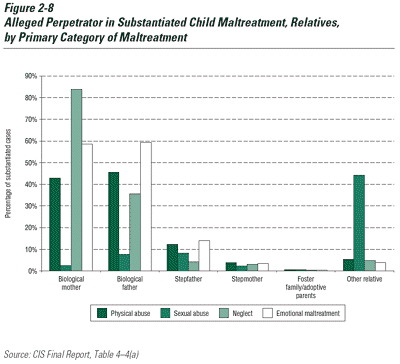
Alleged perpetrators who were
non-relatives (7% of substantiated cases) included
babysitters, family friends, parental partners,
teachers, other professionals, acquaintances, and
strangers. Over half of these non-related alleged
perpetrators (4% of the total) were close to the child
and family, such as friends, parent’s boy/girlfriend,
and babysitters. It should be noted, however, that in
many instances non-familial allegations of abuse are
investigated by the police, not by a child welfare
authority.22
Figure 2-8 shows alleged perpetrators who
were related to the child, broken down by the four
primary categories of maltreatment. Similarly, Figure
2-9 shows alleged perpetrators who were unrelated to the
child. The reader should note that some substantiated
cases had more than one alleged perpetrator, so these
percentages exceed 100%.
Physical abuse was committed
largely by biological mothers and fathers (see Figure
2-8). In particular, fathers were the alleged
perpetrator in almost half (46%) of substantiated cases
of physical abuse, closely followed by mothers (43%).
This distribution may be somewhat biased by the fact
that 40% of investigated families were female-parent
families (discussed in chapter 7 of the CIS Final
Report). Among non-relatives (Figure 2-9), perpetrators
of substantiated physical abuse were primarily parent’s
girlfriend/boyfriend (2%) or babysitters (1%). Although
there were substantiated cases of physical abuse
involving other non-relatives (such as other
acquaintances and teachers), these numbers were very
small and less reliable.
Sexual abuse, in contrast to the
other categories of maltreatment, was committed much
less often by the child’s primary caregiver. Most
alleged perpetrators were either other relatives (44% of
cases) or non-relatives (29%). Figure 2-8 shows that
alleged perpetrators who were related to the child
victim were equally likely to be a biological father or
stepfather and less likely to be the child’s biological
mother or a foster or adoptive parent. Although a
specific breakdown on the particular relationship to the
child of "other relatives" is not shown, it is clear
from Figure 2-8 that this grouping is the single most
significant category of individuals who commit such acts
(44%).
Non-relative alleged perpetrators of
sexual abuse were connected to the child’s life in the
vast majority of cases. As shown in Figure 2-9, they
were family friends (5%), parent’s boyfriend or
girlfriend (2%), babysitters (7%), teachers (4%), other
professionals (2%), other acquaintances (8%) and, in
some instances, a child’s friend or peer (5%). Notably,
very few substantiated sexual abuse cases involved a
stranger (2%).
Child neglect, like physical abuse,
was largely committed by biological mothers (84%) and
biological fathers (36%). Biological mothers may be
over-represented in the neglect category because 40% of
investigations involved female-parent families. The
findings may reflect the interconnection between child
neglect, poverty, and single female-headed households.
Although child neglect rarely involved non-relatives,
babysitters and parent’s girlfriend/ boyfriend taken
together were involved in about 3% of the cases (Figure
2-9).
Emotional maltreatment, like
physical abuse and neglect, was largely committed by
biological mothers (59%) and fathers (59%). Step-fathers
were the alleged perpetrators in 14% of cases. In the
few instances involving non-relatives (3% of the total),
the parent’s boyfriend or girlfriend was implicated.
Summary
An estimated 135,573 child maltreatment
investigations were conducted in Canada in 1998, which
corresponds to an estimated incidence rate of 21.52
investigations per 1,000 children. This incidence rate
includes all child maltreatment investigations,
regardless of whether the investigation was
substantiated or not.
Almost half (45%) of the investigations
were substantiated by the investigating worker. Of the
estimated 21.52 investigations per 1,000 children in
Canada in 1998, an estimated 9.71 per 1,000 were
substantiated, 4.71 per 1,000 were suspected, and 7.09
per 1,000 were unsubstantiated.
The most common primary reason for child
maltreatment investigation in Canada was child neglect,
which accounted for about 2 out of every 5
investigations of child maltreatment. Child physical
abuse was the second most common (31%), followed by
emotional maltreatment (19%), and sexual abuse (10%).
Emotional maltreatment, however, had the highest
substantiation rate, at over half of these
investigations. The other categories of maltreatment had
similar levels of substantiation: about 1 in 3 cases of
physical abuse and sexual abuse were substantiated, and
about 2 in 5 cases of neglect.
Most cases of substantiated child physical
abuse involved inappropriate punishment, and about
one-third involved Read More ..vere forms of abuse. Touching
and fondling of the genitals was the most common form of
abuse in substantiated child sexual abuse. Neglect
involved a number of different parental acts, the most
common concern being failure to supervise the child
properly leading to physical harm. Children’s exposure
to family violence was the most common form of emotional
maltreatment, accounting for well over half of the
substantiated cases.
Child maltreatment was a chronic event in
over a third of the substantiated cases, continuing
beyond 6 months in duration. Emotional maltreatment was
the most likely type to continue beyond 6 months,
followed by neglect, sexual abuse, and physical
abuse.
Physical harm to the child was documented
in 16% of all substantiated cases. Physical abuse was
the most common category of maltreatment that resulted
in physical harm. In addition to physical harm,
emotional harm was noted in one-third of all
substantiated investigations. Emotional harm was noted
most often among sexually abused children, and many of
these children required treatment for such harm.
There was a clear distinction between the
alleged perpetrators of child sexual abuse and those of
the other three categories of substantiated
maltreatment. Biological parents, in particular, were
less likely to be the alleged perpetrator of this
category of maltreatment, whereas they were the
predominant offender in the other three categories.
Other relatives and non-relatives constituted the vast
majority of alleged perpetrators of child sexual abuse,
almost all of whom had a known connection to the child
victim by virtue of their family ties or
responsibilities (e.g. teachers, babysitters, family
friends).
Back
| Table
of Contents | Next...
|